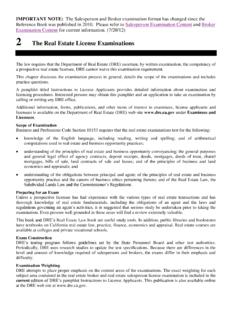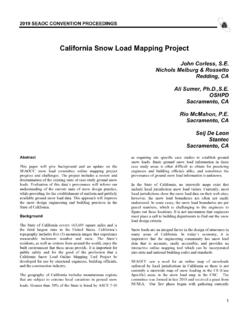Transcription of PIPELINE TYPES; REGULATORY DEFINITIONS
1 PIPELINE TYPES; REGULATORY DEFINITIONSJune, 2006 The Pacific states /British Columbia Oil Spill Task Force has undertaken a multi-year project focused on improving our member agencies ability to prevent, preparefor, and respond to crude oil and petroleum product spills from pipelines. Wecompleted a project six years ago which was focused on identifying gaps in SPILLPREVENTION regulations (a project report is available on our website); this newproject will be even more comprehensive. A project description is available in ourAnnual Work Plan available at the first phase of this new project, the Task Force Members charged theCoordinating Committee and Executive Coordinator to Review and report onfederal and jurisdictional regulations as well as any voluntary programs -governing PIPELINE spill prevention, preparedness, and response, including trainingrequirements for operators.
2 Review DEFINITIONS and categorization of regulatedpipelines to determine which types are regulated. Also report on the status ofGeographic Response Plans for pipelines in each jurisdiction. In an effort to review the DEFINITIONS used by regulators, we surveyed 15 responses are organized below by federal or state/provincial agency. TheState of Hawaii is not included because it defers to US Federal agencies, althoughthe Hawaii Department of Health does have oversight of the PIPELINE SafetyCommittee. Please note that our focus here is on petroleum and hazardous liquidpipelines, not on gas OF CONTENTSF ederalUS Environmental Protection AgencyPages 1-5 Minerals Management ServicePages 1-5US DOT ( PIPELINE & Hazardous Materials Safety Administration)
3 Pages 1-5 National Energy Board of CanadaPages 1-5 State/ProvincialCalifornia Office of Spill Prevention and ResponsePages 6-10 california Division of Oil, Gas, & Geothermal ResourcesPages 6-10 california State Fire Marshall s OfficePages 6-10 california State Lands CommissionPages 6-10 Washington Department of EcologyPages 11-12 Washington Utilities & Transportation CommissionPages 11-12 Oregon Department of Environmental QualityPage 13 Alaska Department of Environmental ConservationPages 14-16 British Columbia Oil & Gas CommissionPages 14-16 PIPELINE Types; REGULATORY DEFINITIONS ; June 20061US & CANADIAN FEDERAL AGENCIESPIPELINE TYPEUS DOT PIPELINE & HAZARDOUSMATERIALS SAFETYADMINISTRATIONUS MINERALSMANAGEMENTSERVICEUS EPANATIONAL ENERGY BOARD OF CANADAON-SHORETRANSMISSIONLINE OR PIPELINESYSTEMThe regulations applicable to hazardous liquidpipelines, which include both crude andpetroleum product lines are found at 49 CFRP arts 195 and 199.
4 The statutory provisionsare found at 49 USC 60101 et 49 CFR Part , the definition of pipelineis: PIPELINE or PIPELINE system means all partsof a PIPELINE facility through which a hazardousliquid or carbon dioxide moves intransportation, including, but not limited to,line pipe, valves, and other appurtenancesconnected to line pipe, pumping units,fabricated assemblies associated with pumpingunits, metering and delivery stations andfabricated assemblies therein, and breakouttanks. PHMSA does not use the terms transmission ortransportation line with respect to hazardousliquid formore general rule is that PHMSA regulates allpipeline transportation in or affectinginterstate or foreign commerce, includingpipeline facilities on the Outer ContinentalShelf.
5 (a). There are many exceptionsto applicability. (b)Not regulated byMMSP ipelines are transportation-related andpursuant to Executive Order 12777, theresponsibilities are split between DOIand DOT. To clarify EPA s role, an MOUwas signed by DOI, DOT and EPA in late1993/early 1994. Appendix B of 40 CFRPart 112 contains this MOU. If adischarge occurs from a PIPELINE , thenthe US EPA would typically get involvedbecause the discharge may be a violationof the Clean Water Act as amended bythe Oil Pollution Act of 1990 (OPA 90).Also, EPA s definition of facility at 40 CFR Part includes NEB regulates inter-provincial and international is defined in the National Energy Board Act section 2 asfollows.
6 PIPELINE " means a line that is used or to be used for thetransmission of oil, gas or any other commodity and thatconnects a province with any other province or provinces orextends beyond the limits of a province or the offshore area asdefined in section 123, and includes all branches, extensions,tanks, reservoirs, storage facilities, pumps, racks, compressors,loading facilities, inter-station systems of communication bytelephone, telegraph or radio and real and personal property, orimmovable and movable, and works connected to them, but doesnot include a sewer or water PIPELINE that is used or proposed tobe used solely for municipal Onshore PIPELINE Regulations, 1999 - SOR/99-294 National Energy Board Processing Plant Regulations -SOR/2003-39 National Energy Board PIPELINE Crossing Regulations, Part I -SOR/88-528 National Energy Board PIPELINE Crossing Regulations, Part II- SOR/88-529 Guidance notes Guidance Notes for the Onshore PIPELINE Regulations, 1999 -Amendment 1 (20 January 2003) Guidance Notes for the National Energy Board ProcessingPlant Regulations (28 July 2003) PIPELINE Types; REGULATORY DEFINITIONS .
7 June 20062 PIPELINE TYPEUS DOT PIPELINE & HAZARDOUSMATERIALS SAFETYADMINSTRATIONUS MINERALS MANAGEMENT SERVICEUS EPANATIONAL ENERGY BOARDOF CANADAOFF-SHORETRANSMISSIONLINE OR PIPELINESYSTEMAs noted above, PHMSA regulates allpipeline transportation in or affectinginterstate or foreign commerce, includingpipeline facilities on the OuterContinental Shelf. (a), althoughthere are many exceptions toapplicability with respect to offshorelines. (b) Offshore means beyond the line ofordinary low water along that portion ofthe coast of the United states that is indirect contact with the open seas andbeyond the line marking the seaward limitof inland waters. Code of Federal Regulations (CFR) : DOI pipelines include: (1) Producer-operated pipelines extending upstream(generally seaward) from each point on the OCS at whichoperating responsibility transfers from a producingoperator to a transporting operator; (2) Producer-operated pipelines extending upstream(generally seaward) of the last valve (includingassociated safety equipment) on the last productionfacility on the OCS that do not connect to a transporter-operated PIPELINE on the OCS before crossing into Statewaters; (3) Producer-operated pipelines connecting productionfacilities on the OCS.
8 (4) Transporter-operated pipelines that DOI and DOThave agreed are to be regulated as DOI pipelines; and (5) All OCS pipelines not subject to regulation under49 CFR parts 192 and 195. And: Pipelines are the piping,risers, and appurtenances installed for the purpose oftransporting oil, gas, sulfur, and produced water. (Pipingconfined to a production platform or structure iscovered in Subpart H, Production Safety Systems, and isexcluded from this subpart.) US EPA does not regulate coast: the NEB jointlyregulates with the Canada-NovaScotia Offshore Petroleum BoardSable Offshore Energy coast: there are no Types; REGULATORY DEFINITIONS ; June 20063 PIPELINETYPEUS DOT PIPELINE & HAZARDOUSMATERIALS SAFETY ADMINISTRATIONUS MINERALS MANAGEMENTSERVICEUS EPANATIONAL ENERGYBOARD OF CANADAGATHERINGOR FLOWLINE Gathering line means a PIPELINE mm (8 5/8 in)or less in nominal outside diameter that transportspetroleum from a production facility.
9 Does not regulate onshore gathering linesin rural areas except gathering lines in the inlets ofthe Gulf of Mexico subject to (b)(4)PHMSA does not regulate flow lines which areconsidered part of onshore production. (b)(7). Production facility is defined in ; flow line is agency plans to initiate rulemaking on theregulation of liquid gathering lines in 2006. TheRegulatory Identification Number for therulemaking on the OMB Unified Agenda is does not have a specific definition forgathering or flow lines. However, MMS doeshave flow line regulations covering these typesof lines at 30 CFR ; and pipelines at 30 CFR 250 Subpart lines or flowlines are not explicitly defined, butproduction facility is defined in 40 CFR Part asfollows.
10 Production facility means all structures (includingbut not limited to wells, platforms, or storage facilities),piping (including but not limited to flowlines or gatheringlines), or equipment (including but not limited to workoverequipment, separation equipment, or auxiliary non-transportation-related equipment) used in the production,extraction, recovery, lifting, stabilization, separation ortreating of oil, or associated storage or measurement, andlocated in a single geographical oil or gas field operated bya single operator. See: PIPELINE definitionabovePUMPSTATIONPHMSA has no definition, but the definition ofpipeline includes pumping units and fabricatedassemblies associated with pumping units ( ) provides special regulations for regulated by MMSSame as facility piping aboveSee PIPELINE definitionabovePipeline Types; REGULATORY DEFINITIONS .





![CHAPTER 7A [SFM] MATERIALS AND CONSTRUCTION …](/cache/preview/c/2/9/8/1/6/8/c/thumb-c298168c48650f700893e26320545ad4.jpg)


